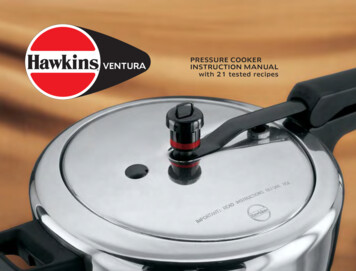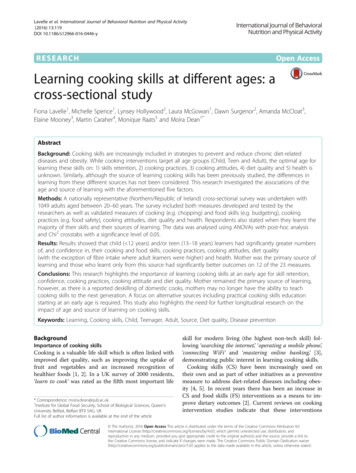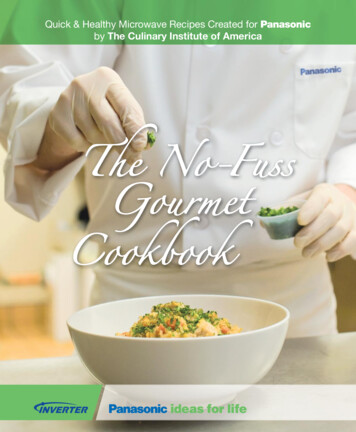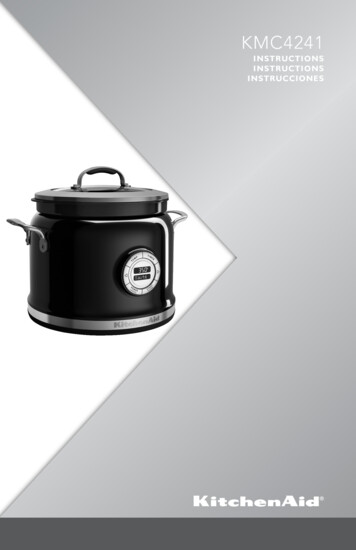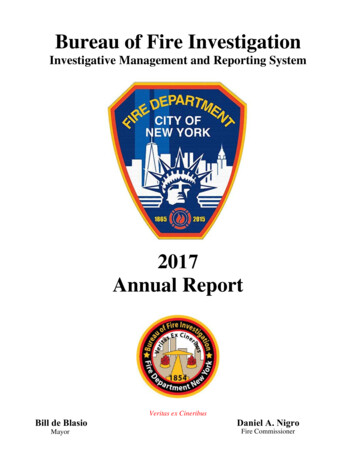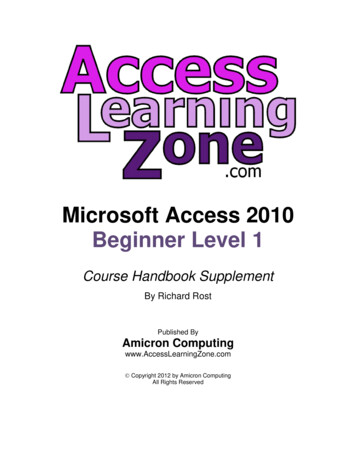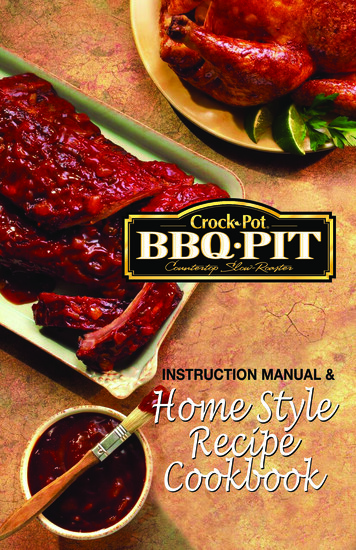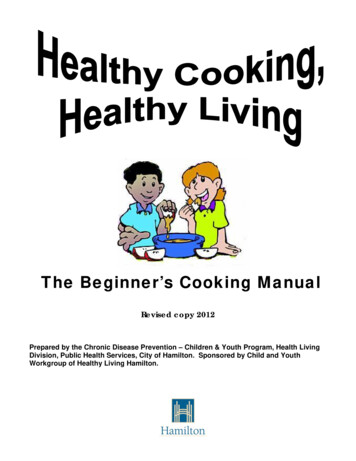
Transcription
The Beginner’s Cooking ManualRevised copy 2012Prepared by the Chronic Disease Prevention – Children & Youth Program, Health LivingDivision, Public Health Services, City of Hamilton. Sponsored by Child and YouthWorkgroup of Healthy Living Hamilton.
Healthy Cooking, Healthy LivingThe Beginner’s Cooking ManualDisclaimerThe Healthy Cooking, Healthy Living – Beginner’s Cooking Manual was developed byCity of Hamilton Public Health Services and sponsored by the Child and YouthWorkgroup of Healthy Living Hamilton. The material contained in this Manual is providedfor general guidance only and while it may be used and reproduced by other individualsand organizations, the City of Hamilton assumes no liability or responsibility for any lossor damage caused or alleged to be caused directly or indirectly by the information in thisManual or resulting from unsafe food handling practices.Healthy Living Hamilton was funded in part by the Government of Ontario. The viewsexpressed in these materials do not necessarily reflect those of the Government ofOntario.For more information about the Beginner’s Cooking Manual, please contact:Chwen Johnson, MSc, RDPublic Health DietitianChronic Disease PreventionHealthy Living DivisionPublic Health ServicesTel: 905-546-2424, ext. 5020Fax: 905-546-3658Email: chwen.johnson@hamilton.caHealthy Cooking, Healthy Living2The Beginner’s Cooking Manual
Table of ContentsDISCLAIMER.2Background.6Aim.6The Lesson Plans .6The Recipes.7GROUP MANAGEMENT.8Helping Students To Set Ground Rules .8Managing Your Group.8Contracting Good Behaviour.8Setting Your Standard.9Tips for Cooking with Kids.9Planning Ahead.10Before Each Session.10Start /During Session .10End of Session or During Meal Time .11Facilitator Set-up Checklist .11Clean-up Checklist .11SAMPLE FORMS .12Sample School Letter.13Sample Participant Letter.14Permission Letter .15Attendance Sheet .16Lesson Review Sheet .17Menu Mind Map .18Task Assignment Sheet .20LESSON PLANS .21Lesson Plan 1 - Hand Washing, Kitchen Safety, Knife Safety .22Lesson Plan 2 - Danger Zone, Cross-Contamination.32Lesson Plan 3 - Manual Utensil & Dishwashing.38Lesson Plan 4 - Reading a Recipe, Kitchen Equipment.42Lesson Plan 5 - Measuring Ingredients.49Lesson Plan 6 - Basic Table Manners, Setting a Table .53Lesson Plan 7 - Trimming the Fat, Taste the Flavour .58Lesson Plan 8 - Dietary Fibre.60Lesson Plan 9 - Vegetables and Fruit .62Lesson Plan 10 - Healthy Eating.67Healthy Cooking, Healthy Living3The Beginner’s Cooking Manual
BEGINNER COOKING CLUB RECIPES.70Salads .71Snacks .77Entrees.84Breakfast.94Vegetables .100Desserts.104APPENDIX A .109Certificate of Completion.110Student Evaluation Form.111Parent Volunteer Evaluation .113APPENDIX B .115Suggested Start-up Equipment .116Additional resources:.118How to Cook Pasta .119How to Blanch and Refresh Vegetables.120How to Cook Rice .121Cooking Terms and Techniques .122ADDITIONAL HANDOUTS .123Canada’s Food Guide to Healthy Eating .123Trim the Fat, Taste the Flavour .123Fat Facts .123Fit Fibre Into Your Day .1235 to 10 a Day for Better Health.123Healthy Cooking, Healthy Living4The Beginner’s Cooking Manual
AcknowledgementsHealthy Cooking, Healthy Kids – Youth Cooking Club Manual (2000) was co-written by MichelleTobias-Murray, BA, B. Ed. and the Nutrition Promotion Program, Public Health and CommunityServices Department, City of Hamilton.Public Health Services, Healthy Living Division, Chronic Disease Prevention, Children & YouthProgram and Healthy Living Hamilton would like to thank the following individuals and groups fortheir valuable contribution to the revision of the Healthy Cooking, Healthy Kids – Youth CookingClub Manual to the Healthy Cooking, Healthy Living – Beginner’s Cooking Manual (2006): The Child and Youth Workgroup of Healthy Living Hamilton. The parents and administration from local schools running the program since 2000. Veronica Kozelj, Public Health Inspector, Health Protection Division, Public HealthServices, City of Hamilton.Healthy Living Hamilton was funded in part by the Ontario Ministry of Health & Long Term Care,Community & Health Promotion Branch.Healthy Cooking, Healthy Living5The Beginner’s Cooking Manual
IntroductionA cooking club is a great opportunity for everyone to learn how to prepare and enjoy healthyrecipes in a fun and inviting kitchen atmosphere. Cooking clubs for healthy eating was part of abroader vision for healthy living in the City of Hamilton.BackgroundCooking clubs are popular for children between the ages of 11 to 13. Children at this age showan eagerness to learn to cook. They are open to learn life skills and are beginning to takeincreased responsibility for their health and well being. Healthy decisions about diet, activity andtobacco use made early in life can result in less chronic diseases later in life.AimCooking clubs introduce children to healthy eating in a practical setting that encourages skilldevelopment. The cooking club experience will help children: Identify and select healthy foods Understand how to prepare foods using good sanitary practices Prevent injury in the kitchen Learn basic food preparation skillsCooking clubs give children a chance to appreciate healthy foods firsthand and gain confidencein their ability to produce tasty and healthy meals.The Lesson PlansThis manual consists of 10 lesson plans and 1 take-home introductory package. The first threelesson plans are compulsory as they contain important information students must knowregarding food safety and sanitation. Facilitators can choose to implement some or all of theremaining lesson plans with their group. Each lesson plan consists of the following 5components: Get ReadyObjectivesKey PointsCooking ActivityCleaning ActivityHealthy Cooking, Healthy Livingoutlines things to prepare before the class.outlines goals of the lesson plan.outlines potential discussion points of the lesson plan.outlines cooking instructions and discussion points.outlines things to do for cleaning and sanitation.6The Beginner’s Cooking Manual
Overheads for each lesson plan are provided to help facilitators summarize key points of thelesson. A “Menu Mind Map” is included in the sample forms session. It can be used as a paperactivity for students while dinner is cooking or as a take-home assignment.The RecipesThere are 30 recipes in the manual grouped into 5 categories: Salads, Snacks, Entrées,Breakfasts and Vegetables. Recipes provide the amounts of ingredients required for serving 4,8 and 12 persons. The facilitators will choose 1-3 recipes each week to try to create a balancedmeal with the group. For example, if you choose the recipe for spaghetti and meatballs, you canpurchase milk to drink and fresh fruit for dessert to create a simple balanced meal.The sample task assignment sheet can be used to help divide up cooking tasks among clubmembers. For efficient use of time, try to choose recipes that require different cookingequipment or tools.Healthy Cooking, Healthy Living7The Beginner’s Cooking Manual
Group ManagementHelping Students To Set Ground RulesProviding a take-home introductory package for students and parents (sample provided) beforethe first cooking session will enable the students to become familiar with some preliminaryground rules. With the students, discuss which behaviors the club members will absolutely nottolerate. For example, “No swearing”, “No horseplay”, “No teasing”. The fewer hard fast rulesyou have, the less likely you are to corner yourself. Remember, this is an after school activityand students are there to have fun. So a “No loud talking” rule may not be appropriate.In addition, look at your facility for safety hazards. Do you need rules to protect club membersfrom personal injury? Do you need to have rules to protect personal property? Are there schoolrules that you should be aware of? You will need to enforce these.Managing Your Group Convey your expectations Ensure rules being followed Make students accountable by having them sign an agreement (e.g. student contract) Assign tasks and ensure their completion Remind students to clean as they go Be firm, but respectfulContracting Good BehaviourA student contract is included in the take-home introductory package. For this to be meaningfulfor the club members, they should help to set the criteria for each behaviour concept outlined onthe handout “Positive Participation”. Student involvement in setting their own standards goes along way to building a partnership between students and facilitators. When students suggest thestandard for behaviour, they are more likely to commit to it. This also creates the expectationthat those around them also have to commit to this behaviour.Facilitators can continue to build an atmosphere of mutual respect and mature behaviour bydealing positively with students who disrupt others. For example, “ That’s an excellent point,Jane, but you are interrupting Tom.” Remind students that they are young adults and that adultlike behaviour is what you expect from them. On the other hand, dangerous or maliciousbehaviour should be dealt with swiftly. Depending on the severity of the behaviour, or theresponsiveness of the student to comply, this action should be done in one of the followingHealthy Cooking, Healthy Living8The Beginner’s Cooking Manual
ways: talk to the student in private about his or her behaviour, ask the student to leave, or callthe administrator on duty to remove the student. Do not get into a shouting match with astudent. Do not take the student off alone somewhere to talk to him or her. Discipline in view ofothers. Adults, even in non-contentious situations, put themselves at risk (of accusations) whenalone with a student.Setting Your StandardHave the club members address facilitators by their last names (Mr. Mrs. Ms. etc.). By doing thisyou maintain a position of authority, which you may be required to exercise in a disciplinarysituation. Generally, the students accept and expect to be on a last name basis with adults inschool related activities. The mutual respect that you build into your sessions is key to acomfortable rapport with the students.Modeling behaviour is also important. Your attitude towards the students, as a group orindividually, will be reflected in their attitudes. If you want students to be scrupulous about handwashing, so must you be. If you want them to respect you, you must also respect them.Finally, when assigning students to work with each other, take into consideration theirpersonalities and requests. If a student tells you they really can’t work with so-and-so, considertheir request. You may possibly avoid a lot of conflict. Be flexible when assigning groups.Tips for Cooking with Kids Show and Tell. Show them and explain to them everything you’re doing and why. Give them tasks. Tell them what needs to be done and assign tasks. Compliment them. Be encouraging and proud of their efforts – big or little. Keep an eye on them. Never leave them unattended when they are cooking. Teach them life skills. Explain to the kids how to purchase fresh fruits and vegetables,why they should wash them, and how to store them.Healthy Cooking, Healthy Living9The Beginner’s Cooking Manual
General Planning Notes forVolunteers/FacilitatorsPlanning AheadMake copies of the take-home package to distribute to each student to review prior to the startof the cooking club.The following administrative forms should be completed or collected from participants prior to oron the first day of the cooking club:Locate or assemble First-Aid kit and have on hand for every session.Permission Letter signed by participant’s parent/guardian. (in take-home package)Student Contract signed by participant and parent/guardian. (in take-home package)Create a student (participant) information binder with permission forms and healthinformation in case of emergency. Be sure to have this on hand at every cooking session.Determine which parent volunteer(s) will be responsible for the student informationbinder.Before Each SessionDetermine tasks for each parent volunteer: facilitation of lesson plans, shopping,administration etc.Purchase groceries. Ensure that you can properly store them until the club meeting.Photocopy the required number of recipes, handouts, “Menu Mind Map”. If yourphotocopy budget does not allow you to give copies of everything to each student,consider making and using overheads where practical.Request for an overhead projector if necessary.Check grocery list and supplies. Is there any equipment you don’t have that is absolutelynecessary?Check your equipment. Is everything where it should be and in proper working order?Decide where cooking stations will be for each group for the session.If last session, prepare Certificates of Completion.Start /During SessionDo a quick attendance. Are students who are not present accounted for?Review ground rules, safety and sanitation guidelines from the take-home package.Review lesson plan objectives, background information, recipes. Ask and answerquestions based on learning objectives.Choose a tip from each category to be inserted into the “Menu Mind Map” as a paperactivity if time is permitted.Healthy Cooking, Healthy Living10The Beginner’s Cooking Manual
Assign groups and tasks using Task Assignment Sheet. Combine duties if there are notenough students for each task.Remind groups to complete set-up checklist.While dinner is cooking, complete a paper activity, e.g. puzzle or questionnaire (if timepermits).Assign cleaning tasks.End of Session or During Meal TimeComplete lesson review sheet with the whole group.Ask: What of tonight’s meal would you make at home?Ask: Which recipes will we make next week?Review clean-up list.Complete clean up.Check pantry supplies.Ensure the kitchen is clean and all food and equipment has been put away properly.Check and close up room.If this is your last session, distribute certificates of completion.Facilitator Set-up ChecklistBags and backpacks put away.Long hair tied back.Outdoor coats removed, apron on.No gum or candy.Hands washed before handling food/equipment.Recipe reviewed and understood.Work areas wiped and sanitized.Equipment and ingredients assembled.Clean-up ChecklistEquipment washed, dried and returned to proper place.Sinks and drains are food free and clean.Countertops and cutting boards have been washed and sanitized.Stove tops and burners are grease and stain free.Stove elements and ovens are turned off.Ingredients have been properly covered and put away.Garbage and recyclable materials sorted and disposed of.Linens have been put away or set aside for laundering.Healthy Cooking, Healthy Living11The Beginner’s Cooking Manual
SAMPLE FORMSHealthy Cooking, Healthy Living12The Beginner’s Cooking Manual
School LetterheadSample School LetterDate:Dear Parents,School is considering starting a weekly after school Beginner’s CookingClub. The cooking sessions can run for a series of 6 -10 weeks, with each session lasting about 2 hours.A cooking club is a great opportunity for students in grades 6 through 8 to learn how to prepare andenjoy healthy recipes in a fun, safe, and inviting atmosphere. Children aged 11-13 are eager to learn tocook and are beginning to take increased responsibility for their own health.Parent volunteers will: shop for recipe ingredients (each parent volunteer will not need to do this) guide the students through a series of nutritionally balanced food and kitchen safety rules eachweek help students prepare a meal each week learn how to serve healthy foods on a budget share the meal with the club membersStudents will: learn simple food preparation techniques prepare a meal and serve the food with proper table etiquette share the meal with their club member friends and parents help with clean-up take the recipe home to share and re-create with their familyEach session of the series of cooking classes will be held (where). Thecost per student to join the club will be weekly. The student and parentvolunteers will be having supper at school the evening that the Beginner’s Cooking Club has its session.Parents will need to arrange for pick-up of their child(ren) at the end of every session.If you are interested in having your child participate in the club, or if you are interested in becoming aparent volunteer, please sign the form below and indicate which day of the week is preferred for clubsessions.Thank you for your interest.School Principal: School Public Health Nurse:Student Name and Grade:Parent Name:Yes. I am interested in a parent volunteer position. Phone number:Day of week preferred (please circle): MONHealthy Cooking, Healthy LivingTUE13WEDTHUFRIThe Beginner’s Cooking Manual
School LetterheadSample Participant Letter(School Name) Beginner’s Cooking ClubDear Parents:(School Name) is ready to cook! Your son/daughter expressed aninterest in our after-school Beginner’s Cooking Club. The cooking sessions will be offeredevery , starting (Date), for a series of weeks, ending on .Each session will run from to pm.The Beginner’s Cooking Club is an opportunity for students in grades 6-8 to learn how toprepare and enjoy healthy recipes in a fun, safe and inviting atmosphere. Students will: Learn simple food preparation techniques Prepare a meal and serve the food with proper table etiquette Share the meal with their club member friends and volunteers Help with clean-up Take the recipe home to share and re-create with their familyEach session of the Club will be held in the (location) . The cost per studentto join the club is weekly. Every session, students will get to eat what they haveprepared.Please complete the attached permission form to have your child participate in the Club, submitthe indicated fee ( total for all sessions), and have your child return all items to the officeon date.Happy Cooking!PrincipalHealthy Cooking, Healthy LivingCooking Club Coordinator14The Beginner’s Cooking Manual
School LetterheadPermission Letter(School Name) Beginner’s Cooking ClubStudent Name:Student’s Home Phone Number:Emergency Contact and Phone Number:Health Card Number (with version code):Family Doctor’s Name and Phone Number:Food Allergies: Food Intolerances:Dietary Restrictions:Medical Conditions /medications necessary to note regarding performance in the Beginner’sCooking Club:How will your child go home at the end of each session?Must wait to be picked up.Travel home has been arranged with:I give permission for my son/daughter to participate(child’s name)in the (school’s name) Beginner’s Cooking Club. I am submitting with this form to cover the fee for the full 6 sessions.Parent’s signature: Date:PRINT PARENT’S NAME:Please submit all monies in an envelope labeled “Beginner’s Cooking Club” with your child’sname.PLEASE RETURN THIS FORM BY (Date)Healthy Cooking, Healthy Living15The Beginner’s Cooking Manual
Attendance Sheet(School Name) Beginner’s Cooking ClubStudentDateDateHealthy Cooking, Healthy LivingDateDateDate16DateDateDateDateThe Beginner’s Cooking Manual
Lesson Review SheetPlanning and organizationRecipesWhat went well?What worked well?What didn’t go well?What didn’t work?Next time remember to:Next time remember to:Healthy Cooking, Healthy Living17The Beginner’s Cooking Manual
Menu Mind MapChoose a tip you learned today from each category and write into the properbubble on this weeks mind map.Cooking Tip:Lesson Plan #Safety Tip:Sanitation Tip:Healthy Cooking, Healthy Living18The Beginner’s Cooking Manual
Student Cleaning ScheduleTaskWk 1/NameWk 2/NameWk 3/NameWk 4/NameWk 5/NameWk nsilsDrydishes/pots/utensilsPut topStudents are expected to:9 Wash and dry the utensils, equipment, dishes and pots they used for the recipe9 Clean their work station9 Scrape their plates after eating9 Put away ingredients they used9 Participate in cleaning rotationHealthy Cooking, Healthy Living19The Beginner’s Cooking Manual
Task Assignment SheetRecipe:#TaskResponsiblePerson (s)123456Healthy Cooking, Healthy Living20The Beginner’s Cooking Manual
Lesson PlansHealthy Cooking, Healthy Living21The Beginner’s Cooking Manual
Healthy Cooking, Healthy LivingLesson Plan 1 - Hand Washing, Kitchen Safety,Knife SafetyGetting Ready Review general planning notes & set-up check list.Assemble and photocopy (or make overheads) all resource materials needed for thesession: recipes, overheads & handouts. Organize these materials for easy distribution tostudents.Gather supplies needed for the chosen recipes.Check participant’s names off the attendance sheet.Objectives Participants will be able to state the importance of hand washing.Participants will be able to model proper hand washing.Participants will be able to state at least 3 tips for kitchen safety.Participants will be able to state at least 2 tips for safe knife use.Introduction Welcome participants to the first cooking session. Introduce facilitators by the name theywish to be addressed. Briefly describe your role and objectives of the Beginner’sCooking Club.Ask students to introduce themselves, or introduce themselves to someone near themthat they do not already know.With students, develop a list of ground rules. (Overhead #1)Hand out the “Positive Participation” sheet, brainstorm the behavior criteria for the keyconcepts in “Positive Participation”. Have students fill in the criteria for each concept.(You may have to write criteria on a board or large piece of paper so students can quicklyfill in blanks).Hand out student contracts. Review with students. Have them sign their names. Instructthe students to take their contracts home to be signed by their parents to be returned thefollowing week.Key Points to Cover Discuss importance of hand washing:- reduce risk of getting and giving common cold to others.- help keep food safe.- help prevent the spread of disease.Demonstrate proper hand washing steps (Overhead #2)Discuss when to wash your hands. (Overhead #3)Healthy Cooking, Healthy Living22The Beginner’s Cooking Manual
Discuss tips for safe knife use. (Handout)Cooking Activities Review recipes and tips.Go over the steps necessary to produce the finished products.Assign groups and tasks.Help students get organized and manage time.Demonstrate cooking techniques as needed.Provide verbal cues or physical assistance for some steps in the recipes.Cleaning Activity Assign tasks.Complete clean-up list.Healthy Cooking, Healthy Living23The Beginner’s Cooking Manual
Student ContractName:Cooperation:I will cooperate with my club and team members to get work doneResponsibility:I will be responsible for all work assigned to me (cooking and cleaning)Respect:I will show respect to all those working with me (teachers and students)i.e. I will call adults by their last name (i.e. Miss, Mrs. Mr.)Behaviour:I will conduct myself according to the club rules and requirementsI agree to all of the above cooking club conditions.Student Signature:Parent/Guardian Signature:Date:Please return to facilitator by next club meeting.Healthy Cooking, Healthy Living24The Beginner’s Cooking Manual
Positive ParticipationDiscuss with your club members and facilitator the following statements:Cooperative people are:Responsible people are:Respect others by:Behaviour that is positive is:Healthy Cooking, Healthy Living25The Beginner’s Cooking Manual
Overhead #1 Resp
The Healthy Cooking, Healthy Living - Beginner's Cooking Manual was developed by City of Hamilton Public Health Services and sponsored by the Child and Youth Workgroup of Healthy Living Hamilton. The material contained in this Manual is provided for general guidance only and while it may be used and reproduced by other individuals


